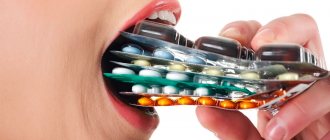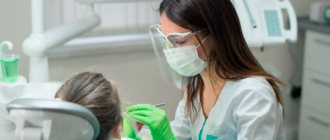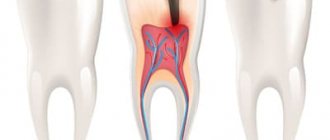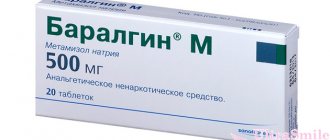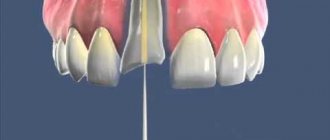Content:
- Forms of release of antibacterial agents used in dentistry
- Contraindications to treatment of flux with antibiotics
- What undesirable effects are possible during the course of medication?
- When you can't do without antimicrobials
- Which antibiotic to choose
- Danger of overdose
- Why you can’t self-medicate
Antibiotics are drugs that exhibit pronounced antimicrobial properties.
They block the growth and spread of pathogenic microorganisms. Dentists prescribe drugs from this pharmacological group for inflammatory gum diseases, purulent processes, and during the recovery period after surgical interventions in the oral cavity. Antibiotics also help with flux. A patient with an inflamed tooth root should not independently select an antibacterial composition. It is important to consider:
- degree of spread of the pathological process;
- associated disorders;
- sensitivity of the pathogen to active antimicrobial compounds;
- speed of regenerative processes.
If you take the wrong antibiotic for flux, the disease will continue to progress. This will disrupt the intestinal microflora. Therefore, never self-medicate.
Antibiotics for tooth root inflammation
For toothache caused by inflammation of the tooth root, doctors also prescribe fluoroquinolones (as for gumboil). In addition, for inflammatory pathologies of the tooth root, antibiotics of the penicillin and tetracycline series are also used. Let's take a closer look at them.
Penicillins
These are the first antibiotics that were discovered by Alexander Fleming in 1928. The main mechanism of action of penicillins is bactericidal. These drugs disrupt the synthesis of peptidoglycan, a component of the bacterial cell wall. This leads to the death of the bacterium.
Currently, different types of penicillin antibiotics are used in dental practice. The most common are amoxicillin and ampicillin.
Tetracyclines
Another class of antibiotics that was discovered a long time ago - back in the 40s of the last century. Tetracyclines act against a wide range of bacteria, both gram-negative and gram-positive microorganisms. The mechanism of action of tetracyclines is inhibition of protein synthesis in bacterial cells. Microorganisms stop synthesizing vital proteins, which is why they die.
Forms of release of antibacterial agents used in dentistry
Dentists use drugs in the form of:
- Ointments and gels. Designed for local treatment of affected gums. Qualitatively relieve inflammation and reduce pain symptoms. As a rule, ointment and gel formulations are applied two to four times a day. It is important to use the medication regularly and strictly according to the regimen selected by a specialist. Only then will it be possible to achieve positive dynamics.
- Tablets and capsules. The most popular types of antimicrobial agents intended for oral administration. The daily dosage is determined by the doctor. When deciding which antibiotics to prescribe, the doctor must take into account the patient’s health condition. It is unacceptable to include in therapy drugs that can aggravate the course of existing diseases of internal organs.
- Solutions for injection. Injections are given intravenously or intramuscularly. This is the most effective option for antibacterial therapy. It is used for complicated and advanced forms of dental disease.
Compresses and lotions for periostitis
Compresses and lotions have a local anti-inflammatory and disinfecting effect, they destroy pathogenic microbes and will help get rid of swelling on the mucous membrane. You can use the drug Dimexide, which is diluted with water until a concentration of 20-30% is reached. The compress is applied to the area of inflammation and left for about an hour.
Soda lotions also help a lot. Baking soda is diluted in a volume of two teaspoons in 200 ml of water. You can moisten a cotton pad or several layers of gauze with the solution and then apply the lotion to the affected area of the gum.
Good therapeutic effectiveness is also observed when using salt compresses. It is enough to dissolve a couple of teaspoons in 100 ml of warm water. A gauze swab soaked in the solution should be applied to the inflamed area and held between the gum and cheek for at least half an hour.
Contraindications to treatment of flux with antibiotics
It is prohibited to use antimicrobial agents that are contraindicated for the patient. Pregnant and lactating women are prescribed medications in this group only if the benefits expected for the mother outweigh the possible risks to the fetus. For young children with weakened immune systems, they always try to eliminate inflammation of the oral tissues without antibiotics.
Before starting antibacterial therapy, it is recommended that you carefully read the information provided in the instructions. Side effects, contraindications, and maximum daily dosages are indicated there. This data is very important. It is unacceptable to ignore them. If you have any questions regarding drug correction, you should consult your dentist.
What undesirable effects are possible during the course of medication?
Side effects depend on the active compound of the particular drug and the individual characteristics of the patient’s body. Common complications caused by long-term antibiotic therapy include :
- Disturbances in the gastrointestinal tract, dysbacteriosis. The conditions are manifested by nausea, loss of appetite, diarrhea, abdominal pain, and flatulence.
- Decreased performance, muscle weakness.
- Dizziness.
- Allergic reactions. Usually these are skin rashes and itching. Swelling also often develops.
If the antibiotic is poorly tolerated, a repeated consultation with the dentist is indicated. It is possible that the doctor will replace the medication with a safer analogue.
When you can't do without antimicrobials
Dentists prescribe antimicrobial agents if:
- inflammation is caused by streptococcal or staphylococcal infection;
- soft tissues in different parts of the oral cavity are infected;
- purulent complications should be urgently prevented or eliminated;
- inflammation progresses despite treatment;
- The patient came to the dental clinic with advanced disease.
Since there is not always time to identify the causative agent of the disease, doctors usually select broad-spectrum antibacterial drugs. They quickly cope with negative symptoms.
Other ways to treat dental and oral infections
The advisability of antibiotic therapy is determined solely by the doctor after diagnosis. In some cases, it is impossible to do without antibiotics, since it is not possible to get rid of the pathogenic infection in other ways.
In some cases, for inflammatory pathologies of the teeth and oral cavity, antiseptic drugs and anti-inflammatory drugs can be used. Folk remedies, for example, rinsing with herbal decoctions, have also proven themselves to be quite effective in the treatment and prevention of inflammatory diseases of the oral cavity. However, remember that traditional medicine cannot be used as the main type of treatment. They can be used as an additional measure to the main treatment.
Which antibiotic to choose
It is impossible to name one medication that would suit everyone. Only a doctor can determine the drug that is effective for a particular patient. To do this, he conducts a survey, examines the oral cavity and performs some diagnostic manipulations.
Among the antimicrobials most often used in dentistry, it is worth highlighting:
- Ciprofloxacin. Broad-spectrum composition. Belongs to the group of second generation fluoroquinolones. Effectively destroys Aggregatibacter actinomycetemcomitans - a gram-negative facultative anaerobic bacterium that causes periodontitis and periodontal disease. It is noteworthy that the medicine practically does not change the microflora of the oral cavity. Therefore, dentists classify it as safe.
- Metronidazole. It is used in the relief of pathologies caused by protozoa, oral bacteria and Trichomonas. Helps with damage to tooth roots, purulent processes, phlegmon, periostitis, abscess, alveolitis and many other diseases of the mouth.
- Doxycycline. Prescribed by specialists at the dental center if severe inflammation of soft tissues, gingivitis, granuloma, or damaged tooth roots are diagnosed.
- Tetracycline. Allows you to cope with the destruction of the periosteum and periodontitis. It has a unique ability to accumulate in the gingival fluid of periodontal pockets, due to which it quickly destroys pathogenic microorganisms.
- Azithromycin. Used in the treatment of inflamed periosteum in patients allergic to beta-lactam compounds. Drink once a day for three days. Moreover, its therapeutic effect persists for several days after the end of the course.
- Amoxiclav. Its active compound is amoxicillin supplemented with clavulanic acid. It is in such a “bundle” that the connection manifests itself best. If you use it in the fight against gumboil in the form of monotherapy, you are unlikely to be cured.
- Lincomycin. It has a pronounced bacteriostatic effect - quickly stops the proliferation of harmful bacteria, which is very important for periosteal pathologies. Destroys streptococci, staphylococci.
Most of the medications listed are available in pharmacies with a doctor's prescription. This once again proves that it is impossible to try to overcome toothache without ever visiting the dentist.
Cold or heat for toothache?
When a tooth hurts, you should take measures for pain relief and then immediately consult a dentist. We always serve patients with acute pain out of turn; Ardent Dentistry finds time for patients according to the degree of their problem.
Analyze your pain, it can be acute, aching, pulsating in nature, appear only in response to cold, sweet foods and immediately disappear, appear at night and intensify during physical work. Since you remember your pain, it will later help the dentist diagnose you and do the necessary tests.
There are many remedies that help with severe and aching dentalgia. They can be carried out as an ambulance before visiting the dentist. Toothache usually appears at the most inopportune times. The only reasonable solution may be to visit the pharmacy and buy pills.
- Ketanov is considered the most effective and fastest medicine for toothache, but has many contraindications and can cause dry mouth, nausea and dizziness;
- Nise is a potent pain reliever, it will help with pain of any origin, it acts for 6-8 hours, which is enough until a visit to the doctor;
- Ketorol - begins to act immediately, effectively relieves pain in a short time, you need to drink it with plenty of water, it is permissible to drink up to 3 tablets per day;
- Ketonal is an anti-inflammatory drug, relieves fever and relieves pain, can be taken from 16 years of age, there is a risk of adverse reactions from the gastrointestinal tract;
- Nurofen is a good pain reliever, also helps relieve fever and inflammation, suitable for treating gingivitis and stomatitis;
- Nimesil is an NSAID indicated for severe toothache; it is available in powder form, which must be diluted in a glass of warm water.
Pills do not always have good results; all medications have side effects. Luckily, there are other options for pain relief at home.
Simply rinsing your mouth should not be avoided or underestimated. Soda is the simplest method, it is found in almost every home, but there are other ways to rinse your teeth when you have a toothache. A good option is rinsing with sage decoction. Other roots and herbs also have antiseptic properties - these are chamomile, calamus root, calendula or plantain; they can also be used for rinsing.
Rinses, medications, as well as simple cooling, what to choose? With acute pain, some kind of inflammation always occurs, and during the inflammatory process, you should never heat the surface. The most important mistake that most patients make is warming up the aching tooth: rinsing with hot decoctions and tea, applying hot compresses. Relief from heat does occur, but it is insidious, since blood circulation increases, pus goes beyond the localization, and infects the blood. The gums become red, swollen and gumboil occurs.
All dentists recommend applying cold , which will prevent the spread of infection and delay inflammation until you go to the doctor at ARdenta dentistry.
You can apply cold while avoiding direct contact with the skin to avoid frostbite. Pieces of ice are placed in a plastic bag and covered with a napkin made of several layers of material. The material will protect your cheek well from the direct effects of cold on the tissue. For some time, the pain will subside, but in the future you need to make an appointment with the dentist, especially since we always have discounts and patients with acute pain have the right to make an appointment without waiting in line. 26
Danger of overdose
Some patients believe that by using higher doses of medication they will be able to recover faster. This is wrong. In the case of any medications, it is important to adhere to the dosage and regularity of use.
If you deliberately increase the number of tablets consumed per day, an overdose will develop. This is an insidious condition that is harmful to health. In the case of incorrect antibiotic therapy, it manifests itself:
- vomiting, nausea;
- dizziness;
- loss of strength;
- discomfort in the abdomen, exacerbation of gastrointestinal diseases (if any);
- allergic rashes.
If an overdose occurs, you should immediately interrupt treatment and consult a doctor.
Why you can’t self-medicate
Antimicrobial agents alone are not able to cure gumboil. Therefore, there is no point in carrying out antibacterial therapy at home and postponing a visit to the dental clinic. Drug treatment begins after cleansing and filling the roots, draining the inflammatory focus. Therefore, what precedes it:
- Opening the crown of a diseased tooth.
- Placement of a special composition into the carious cavity and installation of a temporary filling.
- Removing temporary filling material, cleaning and closing the canals.
- Fixation of a permanent filling.
At the same time, an incision is made in the gum in the area where the “bump” is located so that the pus comes out naturally.
Antibacterial agents are only one of the stages of complex therapy for inflammation of the periosteum of the jaw. It is often possible to do without them. To do this, you do not need to wait until the pain becomes unbearable and the gums become swollen. It is recommended to go to the dentist immediately - as soon as a purulent “bump” appears or a tooth begins to ache.
Types of flux
This pathology is characterized by several stages of its clinical development. At the first stage, minor pain appears. The second stage is characterized by swelling and redness of the gums in the area of infection.
During the third stage, pus appears, the temperature rises, and the cheek and gum area swell noticeably. At the fourth stage, a person feels a sharp throbbing pain, swelling intensifies, and an extensive inflammatory process may begin. The following types of flux exist:
- Ordinary.
The pathological process occurs without infiltration of the periosteum by pus;
- Fibrous.
With this type of periostitis, inflammation spreads to the periosteum tissue;
- Orthodogenic periostitis.
The disease manifests itself in the form of osteomyelitis, which is a serious complication requiring surgical tooth extraction;
- Albuminous flux.
Chronic pathology, which is characterized by a sluggish course, subfertile temperature and suppuration.
Only a dentist can determine the type of disease and prescribe proper treatment, but before visiting, it is necessary to stop the process.
